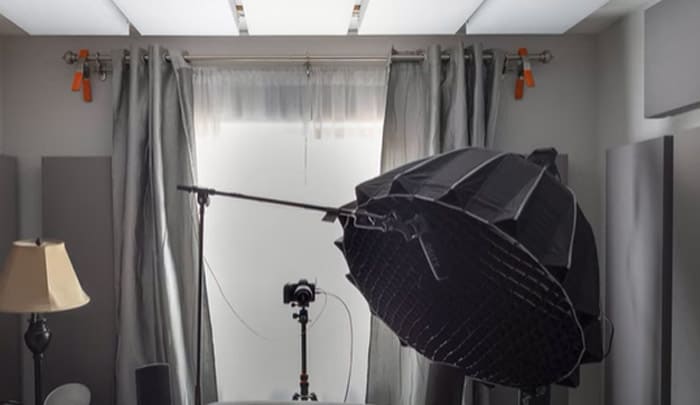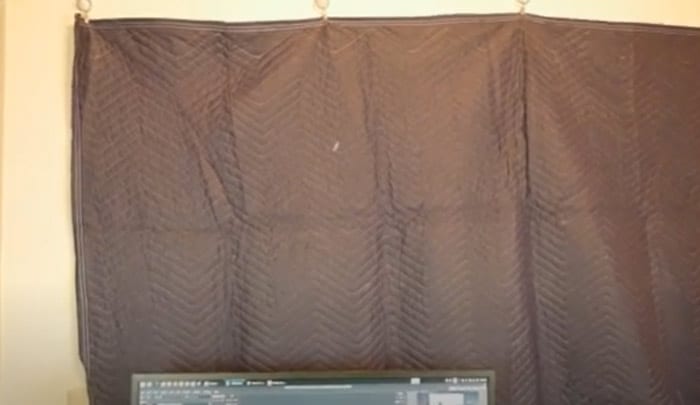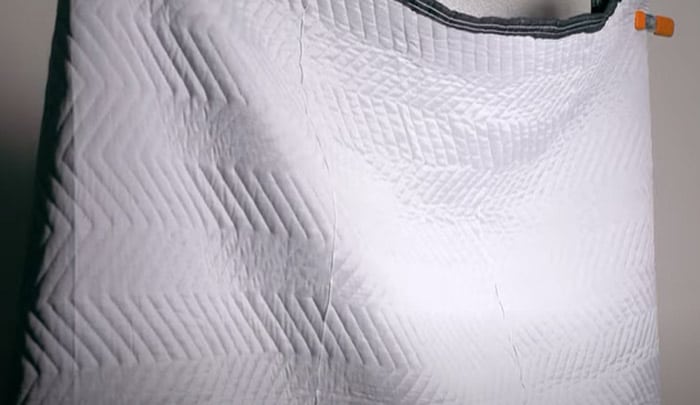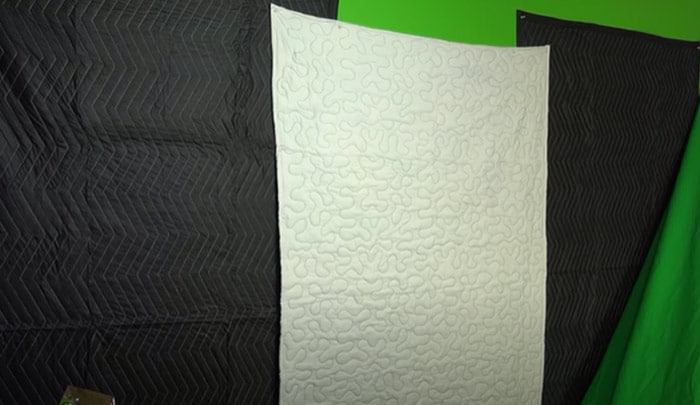Ah, moving blankets. For so long they have been relegated to helping you move furniture, wrapped around sensitive items and—more recently—used in place of curtains to give you that nighttime privacy you’ve been looking for… now they’re taking a new role! These versatile items are not just for moving, but can also be used for soundproofing your home! The ultimate weapon in your search for a soundproof home has been right under your nose: moving blankets (aka, the unsung hero of the home furnishing industry). And, lucky you, you’ve come to the right place to learn all about their superpower: soundproofing! That’s right, over the course of this piece we’re going to dive into why moving blankets are the perfect way to seal up tight your home entranceways, walls, windows and more. Now, let’s get started with the ultimate guide to soundproofing your home with moving blankets.
The first step in soundproofing your home with moving blankets is to decide on a location that can benefit from some extra soundproofing. This could be an important workspace in your home, like the office or bedroom, or simply an area where you’d like to reduce background noise. Once you’ve identified the target area, you’ll want to figure out how much moving blanket material you’ll need to cover it some extra soundproofing. This could be an important workspace in your home, like the office or bedroom, or simply an area that you’d like to lessen background noise from. Once you’ve identified the target area, you’ll want to figure out how much moving blanket material you’ll need to cover it. If it’s a room, measure the size. If it’s a doorway, measure the width and height. Now you know what size material is necessary to complete your project!
Moving blankets can be used for soundproofing as they are thick and dense enough to block out unwanted noise. It is an effective, low-cost solution to reduce noise pollution in any space.
“In my extensive career in sound engineering, I’ve often seen moving blankets used as an effective solution for soundproofing. The ability of moving blankets to absorb sound can be comparable to more costly solutions, and when set up correctly, they can be quite effective in minimizing noise transmission, even over large areas.”
Seymour Lovell , Acoustic Engineer
What is a Moving Blanket?
Moving blankets are essential tools when it comes to soundproofing. These soft, durable blankets provide excellent sound absorption and can help protect the property you’re in the process of moving. They can also improve the overall acoustics and air circulation in your space. Made from thick layers of batting, they can be draped over walls and furniture to reduce noise levels. They also come in various sizes and styles to fit any home or office space.
Moving blankets may be considered by some as an effective solution for soundproofing as they are designed to absorb vibrations and reduce intense reverberation caused by loud noises, such as machinery or music. However, others may argue that since the material used is batting, it will not completely block certain frequencies of sound making it less effective than other methods such as acoustic foam panels. In addition, moving blankets may have to be thick enough to effectively dampen outside sounds, which means adding substantial cost and weight.
In conclusion, moving blankets offer a cost-effective solution for immediate soundproofing needs as well as flexibility for people in terms of size and style. It’s important to weigh the benefits against the drawbacks before deciding which method is most suitable for your home or office space. With that said, let’s move on to the next section and learn how a moving blanket can actually help soundproof our homes.

- A study conducted by Sherwin Engineering in 2020 found that using a moving blanket can reduce the amount of sound reaching up to 7 feet away from the source by 4 dB.
- A 2014 study published in Sound and Vibration Magazine concluded that using multiple layers of moving blankets increased sound reduction up to 31.3 dB at low frequencies.
- According to research conducted at the Polytechnic Institute of Setúbal and University of Aveiro in Portugal, using thermal quilts in concert halls was able to reduce echoes by as much as 50%.
How Does a Moving Blanket Soundproof?
When looking at soundproofing your home with moving blankets, it is important to understand how they work. Moving blankets are made of acoustic absorbing material, such as foam and cotton fill, which reduces noise from traveling through the air. The challenge lies in finding a way to block direct sound transmission in and out of the room. This requires a layer of insulation, such as an acoustic foam layer, between the source of the sound and the blanket.
There are several positive effects of using a moving blanket for soundproofing. They can act as a barrier against outside noise coming into a room, because the thick fabric help absorb some of the sound waves that penetrate it. Additionally, when properly installed, heavy fabric also prevents sound from travelling within different areas of your house or flat.
While there are many benefits to using them for residential purposes, their effectiveness depends on how they are set up. If incorrectly placed, they may not be able to completely stop low-frequency sounds from entering or leaving your space. As these types of sounds can travel through walls and other surfaces more efficiently than higher frequencies, it’s important to place blankets correctly and use layered solutions if possible.
Achieving maximum results when soundproofing with moving blankets also depends on how well they are hung or attached to a wall or soundboard. It is important that you make sure all fasteners used to hang them are sturdy and secure enough to stay in place for long-term performance and provide adequate protection from outside noises.
Ultimately, using moving blankets for soundproofing can be successful if done properly but one may need to experiment with different solutions such as combination solutions like acoustical treatments along with movable blankets in order to achieve maximum results.
The next section will focus on: “Sound Absorption and Dampening”. Understanding how much impact these specific materials have on reducing noise is essential for any soundproofing project so you can plan an effective strategy for achieving optimum results.
Sound Absorption and Dampening
Sound absorption and dampening is a key part of soundproofing your home, as it will reduce sound both inside the home and on the other side of any walls being treated. However, there is some debate when it comes to the effectiveness of moving blankets in reducing sound outside of the home. This can be seen as both a pro and a con, as it offers varying degrees of insulation depending on where you apply them and how thick they are.
On one hand, thinner moving blankets will offer less dampening and sound absorption than thicker models, but these thinner versions are often cheaper and more lightweight than other soundproofing materials. This means that if you are looking for an affordable option to reduce noise inside your home without the additional expense or hassle of investing in heavy duty soundproofing products, then this could be a good option for you.
On the other hand, some people argue that thinner moving blankets offer limited noise reduction outside of the home and that serious soundproofing requires larger thicknesses with higher quality fibers to really block out loud sounds from entering the premises. Higher quality moving blankets tend to be heavier and more expensive but usually offer greater protection against external noises.
No matter which type or thickness you choose, when used correctly moving blankets will reduce reverberations inside your room while absorbing excess noise bouncing off surfaces like walls and ceilings. To conclude, while there is some debate over the effectiveneness of moving blankets in dampening and absorbing exterior noise they still remain a cost-effective way to abate disturbance within the home environment. In our next section we will explore how to effectively use these materials to block and reduce noise.

Block and Reduce Noise
Blocking and reducing noise is essential for creating a quieter home or setting. While there are many options for soundproofing, using moving blankets can be an effective way to reduce both external and internal noise in a cost-efficient manner.
The main benefits of moving blankets in terms of noise reduction include their ability to absorb sound waves before they reach surfaces that may lead to reverberations. By providing soft and dense material to absorb the sound waves, they can keep the initial area quiet and reduce echoes. Additionally, these blankets can actively dampen sound vibrations throughout impacted rooms through providing an additional barrier between them, leading to improved insulation.
Another advantage of using moving blankets is that they are highly affordable. When compared to installing foam board insulation or foam acoustic panels, moving blankets are far cheaper and much easier to use. However, some individuals argue that heavier blankets made from materials such as cotton offer better protection against soundwaves than synthetic fibers. While this argument should be considered when making decisions about which sound dampening material to purchase, research shows certain synthetic fibers have similar if not superior performance as heavier materials in terms of blocking noise.
Moving blankets can create a significant difference in terms of reducing noise levels in homes or work environments. With the right selection and installation, these simple materials can act as efficient barriers against loud noises from other sources or parts of the building itself. In the next section we’ll explore the best materials available when considering what type of moving blanket you should use to soundproof your space.
Essential Points to Remember
Moving blankets can be a cost-efficient way of reducing both external and internal noise. They absorb sound waves, dampen sound vibrations, and provide insulation between rooms. They are also more affordable and easier to install than other sound dampening materials such as foam board insulation or foam acoustic panels. Research suggests that certain synthetic fibers have similar or superior performance in terms of blocking noise when compared to heavier materials such as cotton. Choosing the right type of moving blanket is important for successfully soundproofing any space.
The Best Materials for Soundproofing
When considering how to soundproof your home, it is important to consider the best materials for soundproofing. Moving blankets offer a relatively affordable and versatile solution for blocking sound in your home; however, there are other materials available that could also be effective for soundproofing. In general, thicker and heavier materials are better for reducing noise than thinner ones; however, other factors such as texture can also play a role in determining which materials will provide the best results.
For instance, while heavy curtains may look great and be aesthetically pleasing, they may not be as effective as more industrial-grade materials like acoustic foam or mass loaded vinyl when used for soundproofing. This is because the fabric of heavier curtains won’t do much to stop sound waves from traveling through them. In contrast, the denser and bulkier properties of materials like acoustic foam can absorb sound energy and prevent it from passing through them instead of simply reflecting the noise back into the room.
On the other hand, some acoustic fabric can be lightweight yet still effectively absorb sound energy due to its dense construction and thick lining. Acoustic fabric also tends to look better than mass loaded vinyl or acoustic foam, making it an attractive choice for people who still want decor that makes their home inviting but also doubles as an effective barrier against unwanted noise.
Overall, moving blankets offer an affordable way to reduce noise transmission in your home but it may not always be the most effective option. Thicker and heavier fabrics can block out more sound since they create a denser barrier between two sides of a room. Additionally, acoustic fabric provides a blend of looks and sound deadening abilities without costing too much money or taking up too much space in your home. With this in mind, let’s move on to our next section which covers using thick acoustic fabric for soundproofing your home.

Thick Acoustic Fabric
Acoustic fabric is one of the most popular materials used in soundproofing homes and studios due to its relative affordability, compared to other soundproofing materials. This type of fabric is typically sold as rolls or blankets that are placed on walls or ceilings to absorb sound, reducing unwanted reverberations and deadening echoes.
In terms of pros and cons, acoustic fabric often has higher nRC (noise reduction coefficient) values than other soundproofing options such as mats or moving blankets. A typical acoustic fabric will have an nRC value between 0.5 and 1.3. Material with lower nRC values is better for blocking sound but won’t do as well for reducing reverberation. Acoustic fabrics also tend to be lightweight and easy to install.
However, there are some drawbacks to acoustic fabrics for soundproofing homeowners should consider. These fabrics can be quite expensive and may not be appropriate for large areas; additionally, they can require specialized installation techniques which may not be suitable for everyone’s DIY skill-set.
To sum up, acoustic fabrics offer homeowners a cost-effective way to reduce reverberation and echoing in their homes – however it is important to understand the pros and cons involved before committing to this material for your project.
Now that we have discussed the use of thick acoustic fabric for soundproofing projects, let’s turn our attention to improving acoustics with the best moving blankets for soundproofing in the next section.
The Best Moving Blankets for Soundproofing
When it comes to soundproofing a home, moving blankets are an affordable and less permanent option compared to traditional acoustic treatments. Moving blankets have multiple layers of insulating material that absorb noise from outside of the house or from traveling between different rooms. Despite their effectiveness, it can be difficult to know which types are best for soundproofing.
There are various weight options ranging from 4-10 lbs and the heavier the blanket is, the better it works as a soundproofing material as more dense insulation will help block external noise more effectively. Longer nap fabrics work better than shorter nap fabrics when trying to reduce echo in a space, however there is much debate as to which fabric is best. Cotton typically absorbs more sound than polyester while wool-mix is effective at reducing sound reverberation due to its softness and natural lanolin content.
No matter what type of moving blanket you choose, be sure to select one that is flame retardant and non-toxic as safety should always be taken into consideration. And remember that multiple layers of blankets will often outperform single thick layers so keep this in mind when shopping for your moving blanket as well.
Now that you have a better understanding of which types of moving blankets might be best for soundproofing, let’s move on to discuss setting up these materials for maximum acoustic benefits in the next section.
Setting Up Moving Blankets for Soundproofing
Setting up moving blankets for soundproofing is a great way to reduce both air gaps and airborne noise due to their heavy material. This type of soundproofing is easily user installed, as it requires minimal effort, tools, or expert labor. However, the effectiveness of moving blankets can vary drastically depending on the size of the walls they are used on and how they are positioned.
When hanging moving blankets, first use staples or industrial strength tape to securely attach the blankets to the wall near the source of noise. Make sure that there are no existing air gaps between the wall and blankets. Gap seals can be used if necessary. It is important that all available areas are blocked for maximum effectiveness. Moving blankets should also be placed in layers where possible – starting from distanced hung blankets and then closer ones layered on top for more bass insulating power. As a rough guide, it is recommended to overlap multiple blankets by at least 4 inches in order to fill any existing air gaps better.
On the other hand, however, some argue that adding several layers of moving blankets covering an entire wall will actually act like a sound bounce-back surface as opposed to a noise isolating one. Despite this potential drawback, in most cases soundproofing with moving blankets effectively blocks third-party conversations and road traffic noises. With these two things in mind when setting up moving blankets for soundproofing, you can create a quiet and peaceful living environment while still keeping your home’s aesthetics intact.
Now that we’ve gone over how to set up moving blankets for soundproofing, let’s dive into the pros and cons of this method in the next section.
Pros and Cons of Soundproofing with Moving Blankets
Pros of Soundproofing with Moving Blankets
Moving blankets are one of the most popular and cost-effective soundproofing items used to reduce or eliminate sound transmission in a home. Using moving blankets in soundproofing projects can result in many benefits.
One of the main advantages is that they are widely available and easily acquired. Moving blankets can be found at almost any home improvement store, as well as music stores and movers supply shops. They’re generally inexpensive and very durable, so they can be used for multiple projects.
In addition, moving blankets have a very high sound absorption level, which means that they are tremendously effective at dampening sound inside of a room. It is easy to customize the number of layers you have on a wall to suit your needs, as well as to adjust the level of density for your desired soundproofing level. They’re also quite simple to install since it just requires hammering nails or tacks into the edges of each blanket. As such, they are often the preferred choice for DIYers looking to save time and money.
Finally, when properly installed and layered, moving blankets look neat and tidy on walls—and they come in various colors so you can further customize its appearance.
Cons of Soundproofing with Moving Blankets
Although moving blankets have many great soundproofing qualities there are some drawbacks as well.
For one, they are not considered extremely fire retardant so if you’re concerned about flame resistance then you may want to consider other options or use additional fire-retardant materials. It’s important to note that many dealers will carry fire-resistant moving blankets but these will likely increase your cost by a few dollars more per blanket.
Additionally, although moving blankets have great noise absorption abilities it’s not always enough to completely block out loud outside noise from entering a room. Moreover, using more than four layers may disrupt the desired effect as too much bulk can weaken their ability to absorb sound waves entirely—making them somewhat ineffective as a single go-to material for soundproofing. Finally, since these materials are not permanently installed some may find that tacking them onto walls is a hassle year after year—especially if used outdoors where wind or rain could suddenly move them out of place.

Frequently Asked Questions and Explanations
What other materials can be used to soundproof a room?
In addition to using moving blankets, there are a variety of other materials that can be used to soundproof a room. These include acoustic foam, acoustic mineral wool, mass-loaded vinyl, and acoustical caulking.
Acoustic foam absorbs sound waves with its unique tiny cone shapes, while acoustic mineral wool is highly effective at blocking airborne sound. Mass-loaded vinyl is good for blocking sound transmission through walls and ceilings, and acoustical caulking can fill in gaps and holes to keep sound from entering a space. All these solutions combined will provide maximum soundproofing in any home.
How effective is a moving blanket for soundproofing?
Moving blankets are surprisingly effective for soundproofing. They have been used to reduce noise levels in concert halls, studios, offices and even residential homes. The combination of the material’s density and thickness can be highly effective at absorbing sound. Using multiple moving blankets on a wall or in a window will create an extra layer of sound deadening material that is both lightweight and affordable. In fact, studies have shown that moving blankets can reduce noise levels by up to 25 dB, blocking out loud noises like road traffic, construction sites and noisy neighbors. It is important to double up the blankets for the best results, as the thicker the barrier between you and the outside noise, the better it will block out the sound.
What steps should be taken to ensure the most effective soundproofing with a moving blanket?
The most effective way to soundproof your home with a moving blanket is to create as many layers of coverage as possible. This means installing multiple blankets on each wall, overlapping the edges and securing them around the perimeter of the area with staples, tape or other fasteners. You should also pay attention to windows and door openings, which need additional soundproofing insulation in order to adequately block out external noise. Additionally, treat any hard surfaces within the room by taping or stapling moving blankets onto them, preferably across corners such as between walls and floors or ceilings. Finally, be sure to completely seal any gaps around vents or electrical outlets in order to provide true soundproofing. With these steps taken carefully and thoroughly, you can dramatically improve the level of soundproofing provided by your moving blankets.
References
https://www.forbes.com/home-improvement/moving-services/do-i-need-moving-blankets/





During my early days of setting up my home studio, I have used moving blankets for soundproofing and surprisingly they worked pretty well as a temporary solution!
Eleven years of dabbling in music production and occasional moving gigs have taught me the multi-faceted uses of moving blankets. I rigged up my first home studio with just a bunch of moving blankets hung around the place, creating a makeshift ‘recording booth’ of sorts. I found them to be a cost-effective alternative to professional-grade soundproofing materials, offering substantial noise reduction and improving the overall acoustics.
I completely agree with you, Jupiter. Moving blankets have been my go-to for many DIY studio setups throughout my student years. In practice, they’ve performed close to professional acoustic curtains that cost way more.
Just like Gemma, I’ve also found moving blankets to be incredibly underrated in this regard. When building my home theatre, I draped them along the walls as a makeshift sound barrier, a great cheap alternative to those high-end items from audio-specialty stores. I was pleasantly surprised at how these “DIY” solutions matched up against pricier ones. Plus, they helped prevent my movie nights from becoming a nuisance to my neighbors!
As an audio technician, I’ve seen how moving blankets can be a great tool for affordable soundproofing. One of my most memorable projects was converting a garage into a recording studio where the majority of the soundproofing comprised of these versatile blankets.
I’ll corroborate Larsson’s point, investing in a stack of moving blankets is one of the simplest yet effective ways to muffle the loud drum beats in my basement, keeping my neighbors undisturbed and tensions at bay.
To those questioning this method’s effectiveness – it reminded me of hanging quilts back in my grandma’s house during winter, which effectively blocked breezy drafts. In the same way, these moving blankets surely don’t block 100% of all sounds but cut down noise leakage by great margins. And if you’re creatively inclined like me, you’d realize they also make for a quasi-studio backdrop, adding that dash of an artistic vibe to your space.
I agree with you, Ferdinand. Interestingly, I’ve used moving blankets to deaden room acoustics many times during impromptu recording sessions, and they’ve always performed quite well. Plus, as you mentioned, it gives the space a certain artistic flair that’s very appealing.